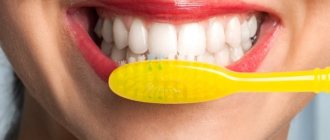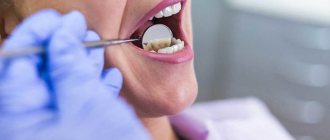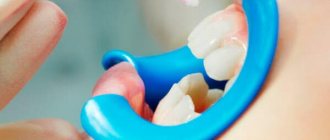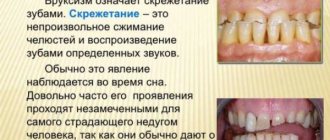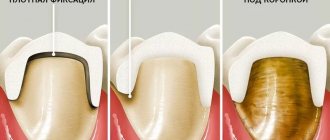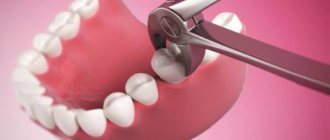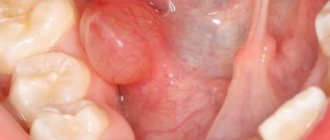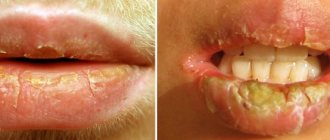The main causes of chronic sinusitis
Chronic sinusitis most often has a bacterial nature, less often - fungal and allergic. The role of chlamydia infection is discussed.
- In 48% of cases, the cause of the chronic form of sinusitis is anaerobes, in 52% of cases - aerobes (Streptococcus, influenzae, P. aeruginosa, S. aureus, M. catarrhalis).
- Cases of chronic sinusitis, in which various fungi are detected, have become more frequent. It is believed that this is due to the uncontrolled use of antibiotics. Fungal sinusitis often develops in people with decreased immunity. The disease always takes a long time and is difficult to treat.
- The role of protozoa in the development of the disease - chlamydia infection is discussed.
- Chronic sinusitis that lasts a long time is often of an allergic nature. Allergic rhinitis is often reported in such patients. The disease develops when the body is hypersensitive to certain environmental substances – allergens. They can be pollen from certain plants, dust mites, animal dander, food, etc. Triggers—tobacco smoke and the odors of certain chemicals—can have a powerful irritating effect.
Fungal
The causative agent of this type of sinusitis is fungi of the genus Aspergillus, Mucoraceae, Candida. Normally, fungi can be found in the human nasal cavity without causing disease, but with decreased immunity, severe chronic diseases (diabetes mellitus, HIV, etc.), long-term use of antibiotics, long-term presence of a foreign body in the sinus (bone fragments after injury or fragments of filling material after dental treatment) fungal sinusitis may occur.
Fungal infections are divided into non-invasive and invasive forms. Non-invasive forms are mycetoma (fungal ball) and chronic allergic fungal sinusitis. Invasive forms are rare and occur in people with severe immune disorders (eg, HIV).
Symptoms of fungal sinusitis in a non-invasive form:
- Headache.
- Nasal congestion.
- Discharge with an unpleasant odor, sometimes mixed with blood streaks.
- Pain in the sinuses and upper molars.
- Polyps in the nasal cavity.
All these symptoms appear against the background of bronchial asthma, chronic allergic rhinitis, diabetes mellitus and other diseases that lead to decreased immunity.
Symptoms of fungal sinusitis in the invasive form:
- High fever;
- Visual impairment;
- Impaired breathing through the noses and massive nosebleeds;
- Pain in the sinuses.
Treatment of fungal sinusitis is surgical and involves removing mycetoma or mucus (for allergic fungal sinusitis). Endoscopic surgery is performed.
Drug treatment includes hormonal drugs that suppress fungal growth and immunostimulants of plant origin (for example, echinacea).
In invasive forms, surgical removal of all necrotic areas is performed. Antifungal drugs, hormonal drugs, stimulating immunomodulators, and immunostimulants are also prescribed for a long term. After treatment, it is necessary to perform a CT or MRI once a month for a year in order not to miss the progression of the disease.
It is important to understand that fungal sinusitis is one of the serious forms of the disease, and only a specialist should treat it!
Traumatic
This type of sinusitis occurs as a result of fractures of the upper jaw and bones of the maxillary sinus. After an injury, inflammation of the mucous membrane of the maxillary sinus occurs and subsequently it detaches from the bone, granulations (growths) and polyps form in the sinus.
Traumatic sinusitis develops with insufficient primary surgical treatment or its absence.
The disease can have an acute and chronic course. The process is usually one-sided, on the side of the injury.
In the acute course of the disease, the patient’s general condition worsens, body temperature rises, sweating, and severe headache appear. In the sinus, an x-ray shows signs of inflammation spreading to the surrounding tissues, phlegmon (widespread purulent inflammation of the subcutaneous fatty tissue) and abscess (purulent melting of tissue) develop. The patient is indicated for surgical treatment with further antibiotics. Treatment is carried out in a hospital.
In the chronic form of the disease, the patient complains of nasal discharge, discomfort (pressing pain) in the maxillary sinuses, headache, and nasal congestion. Also, with traumatic sinusitis, swelling of the cheek and swelling in the eyelid area may appear. A characteristic sign of a chronic inflammatory process in the sinus is the appearance of fistulas (holes) in the infraorbital region with purulent discharge.
Treatment for the chronic form of this disease is surgical. A radical operation on the maxillary sinus is indicated to remove all granulations, polyps and fistulas. In the postoperative period, drug treatment is prescribed with mandatory antibiotics. Treatment is carried out only in a hospital.
The main causes of acute sinusitis
Acute sinusitis is caused by viruses and bacteria. Of the bacteria, the most common are Haemophilus influenzae (21 - 35%) and Streptococcus pneumoniae (21 - 43%), somewhat less common - Streptococcus pyogenes (about 4 - 10%), Moraxella catarrhalis (3 - 10%), Staphylococcus aureus (1 - 8%) and aerobes (1 - 9%).
With ARVI, in 90% of cases, sinusitis of a viral nature develops, which does not require antibacterial treatment. In 1 - 2% of patients with ARVI, the disease has a complicated course.
- A feature of viral sinusitis is the rapid restoration of sinus function without treatment.
- With a disease of a bacterial nature, pain and inflammation manifest themselves to a greater extent than with a viral one. The long-term existence of symptoms of sinusitis indicates its bacterial nature.
Carrying out a computed tomography scan - what the procedure shows
Before prescribing a computed tomography scan, the doctor must familiarize himself with the results of a blood test for sinusitis. A CT scan is performed only as prescribed by a doctor if there is reasonable suspicion of moderate or severe pathologies of the nasal sinuses. The tomograph is usually installed in a separate office, which is divided into two small rooms - in one room there is a machine for creating a series of images, and in the second room there is a computer control panel.
All information about the types of unilateral sinusitis is presented here.
What leads to violation
Thickening becomes a natural continuation of frequent colds, infectious diseases, hypothermia, and allergies. The development of pathology is promoted by:
- rhinitis;
- chronic sinusitis;
- polyps;
- injury;
- excessive intake of medications that negatively affect the immune system;
- acute lack of vitamins and weakening of the body's defenses;
- congenital/acquired deviated septum.
Inflammation of the maxillary sinuses in each of these cases has its own characteristics.
With rhinitis, for example, the process develops not only in the maxillary cavity, but also in the frontal cavity, affecting the area of the larynx and pharynx. The examination reveals changes in the periosteum, the bones of the nasal turbinates, and the growth is observed more in the lower part of the nose. Thickening of the mucous membrane leads to a feeling of complete obstruction, and vasoconstrictor drops do not give a positive result. In addition, patients note deterioration in hearing, smell, and quality of sleep.
Other provoking factors include the development of purulent, purulent-polyposis, necrotic, and parietal sinusitis. Each of these types also has its own characteristics. For example, in the latter case, not only does the mucous membrane of the maxillary sinus thicken, but the layer connecting it to the muscular layer is also affected.
If the maxillary sinuses are not washed in a timely manner, polyps form, and they are indicated by a feeling of congestion on one side. As the size of the formations increases, the wall becomes thicker, and as they increase, it is more difficult to breathe through the nose, and vasoconstrictor drops are of less and less benefit.
At the same time, the person cannot shake the feeling that there is a foreign body in the nose, he always wants to sneeze, and due to constant congestion, the patient tries to breathe through his mouth, which leads to pharyngitis, laryngitis, tracheitis, bronchitis, pneumonia and similar disorders.
We suggest you familiarize yourself with which clasp dentures for teeth are better, types by material and method of fastening
Hypertrophy, which occurs as a result of injury, deviated septum, and disruption of the structure of the nasal cavity, leads to increased secretion production and difficulty breathing during inhalation and exhalation. The person experiences:
- headache;
- discomfort in the area of the upper jaw and wings of the nose;
- worsening sleep;
- the appearance of tinnitus.
Previously appeared discharge becomes cloudy and turns white. The main general symptom is a lumpy appearance of the mucosa, as active formation of pineal seals occurs. All signs are more pronounced against the background of weak immunity and a significant lack of vitamins.
Complications of the disease
Complications are most often the following: meningitis, orbital phlegmon, venous sinus thrombosis. These diseases occur because pathogenic microorganisms enter other parts of the body through the anterior or ophthalmic vein. If the disease is not treated, you can suffer from diffuse osteomyelitis, which destroys the bones of the upper jaw and leads to cosmetic defects. In rare cases, a person may suffer from blood poisoning, damage to the cardiovascular system, or kidneys. This occurs due to the penetration of bacteria into the blood and their spread throughout the body.
If left untreated, sinusitis can cause serious complications.
Diagnosis of the disease
Sinusitis is often well diagnosed. In most cases, a correctly collected medical history and examination of the patient (rhinoscopy) is sufficient to make a diagnosis.
A detailed study is necessary to diagnose chronic asymptomatic sinusitis, post-traumatic and fungal in nature. In-depth diagnosis in this case will be the key to prescribing adequate therapy and cure.
If the diagnosis after examination is still unclear or antibiotic treatment has not yielded results, or if complications occur, additional examination is required.
What does long-term lack of treatment lead to?
Important: degeneration of mucous tissue is very dangerous, as malignant formations may occur.
Long-term changes in the shape and volume of the mucous membrane of the maxillary sinuses lead to hypertrophy of the maxillary sinuses. The nasal septums shift, and the patient begins to experience serious breathing problems.
In addition, the displacement of the shells disrupts their symmetrical arrangement. Impaired free nasal breathing will negatively affect the condition of the entire body. On performance, sleep status, mental balance, oral health and much more.
https://www.youtube.com/watch?v=8Jqy5FAfjIs
Changes in the condition of the nasal turbinates affect the condition of their mucous tissue.
- the asymmetry of the shells provokes uneven air inhalation, the mucous membrane of the shells becomes inflamed;
- when trying to cope with increased loads, the membrane grows, hypertrophy of the mucous membrane of the nasal concha begins;
- secretion increases.
Important: hypertrophic changes in the nasal mucosa can also be provoked by physical impact, trauma to the nose and face.
The purulent stage of the development of the situation is especially dangerous.
Purulent processes in the sinus will have the following symptoms:
- congestion occurs periodically, can be unilateral or bilateral;
- nasal discharge – cloudy, white;
- the jaw, forehead, and sides of the nose hurt;
- the general condition of the patient is rapidly deteriorating;
- the temperature rises.
The best folk recipes
It is possible to improve the patient’s condition with the help of non-traditional methods of treatment, but traditional recipes cannot replace drug treatment. At the same time, traditional medicine is a complement to conservative therapy and helps eliminate symptoms in a short time.
The best folk recipes for inflammation of the maxillary sinuses:
- Ointment based on aloe juice. Mix two tablespoons of aloe leaf juice with 50 g of dioxidine ointment. Mix the ingredients and apply to the sinus area.
- Aloe juice drops. Place aloe juice in each nasal passage three times a day. You can mix the plant juice with onion juice or Kalanchoe, then the effect will be greater.
- Beetroot and carrot juice. Mix beet and carrot juice in equal parts. Instill several times a day. If burning and tingling occurs, it is recommended to dilute with water.
- Propolis tincture. Buy the tincture at the pharmacy and mix it with vegetable oil in a 1:1 ratio. Drip into each nostril 2-3 times a day.
- Horseradish root. It must be peeled, washed and grated. Mix a third of a glass with the juice of three lemons. Mix the mixture and take half a teaspoon orally 20-30 minutes before meals.
- Sea buckthorn oil. 5-6 tablespoons of oil are mixed with 3 drops of fir oil. Next, soak cotton swabs and insert them one by one into the nostrils. Leave in the nasal cavity for 10-15 minutes.
- It is effective to rinse the nasal cavity for sinusitis. To do this, you can use herbs such as chamomile, calendula, cloves, etc. Brew a teaspoon of the herbal mixture or individual herbs and leave to steep for an hour. Strain and use warm for rinsing or instillation.
It should be noted that the use of folk recipes for sinusitis should last at least 2-3 months. Only in this case can positive results be achieved.
Video about when and how a puncture is made for sinusitis:
How to take Biseptol correctly for sinusitis?
How does acute sinusitis develop?
Viral infection “paves the way” for bacteria. In 90% of cases with ARVI, there is swelling of the sinus mucosa, impaired microcirculation and the development of stagnation of secretions. Normally, the mucous membrane of the maxillary sinuses is very thin (like a sheet of tissue paper), but with disease it thickens 20 to 100 times. Swelling of the mucous membrane leads to blockage of the anastomosis, and the outflow of secretions is disrupted.
Impaired drainage also occurs as a result of hypertrophy of the nasal mucosa in the case of allergic rhinitis, polyposis, deviated nasal septum, dental diseases, as a result of trauma and intoxication of various origins.
With the development of acute inflammation in the first, early stages of the disease, the exudate is serous, then mucous-serous, and with the development of a bacterial infection, it is purulent, containing detritus and a huge number of leukocytes.
What are the alternatives?
In addition to X-rays, detection of sinusitis is available using the following diagnostic techniques.
- Computed tomography (CT). Up to a dozen projections of the facial area are performed to obtain a more accurate result. As a result, the condition of the sinusoidal canals, the presence and amount of pus in them, the development of pathologies and complications are determined. The disadvantages are the high level of patient radiation and the cost of the procedure.
- Endoscopy. Provides information about the condition of the nasal and sinusoidal sinuses from the inside. It is carried out by an experienced diagnostician in a hospital setting. The main disadvantage is discomfort due to the use of natural airways for research.
- Puncture. Necessary to determine the nature of the material (fluid or pus) located in the sinuses. Performed only on patients over 6 years of age. Like the previous method, it is characterized by discomfort for the subject. It is performed using local anesthesia.
- Ultrasound. Prescribed before radiography to determine the presence of pathologies in the maxillary sinuses. It is not sufficiently effective for diagnosing sinusitis, and therefore is rather intermediate in nature.
- Bacteriological diagnostics. Necessary for determining the type of bacteria that caused inflammation and selecting the most effective drugs to combat them. The procedure is carried out in several stages, as it has specific features for the throat and nose.
- Additional consultations. Needed if the inflammation cannot be identified or has a controversial origin. For example, it can be a side effect of allergies, dental diseases, or intracranial complications.
- General inspection. It is carried out by palpation. If there is pain in the sinus area, the doctor can tell in absentia about the development of sinusitis.
We suggest you read: How is Nurofen used for toothache and teething?
Why does this type of sinusitis occur?
The main cause of the disease is inflammation of the upper jaw or a certain area of the gum. Typically, the culprit of this disease is a pathogenic environment that includes staphylococci, streptococci, various bacilli, and yeast fungi. There are other reasons for this problem.
- Odontogenic periostitis and osteomyelitis, chronic periodontitis, periodontitis with pus discharge, purulent cysts in the jaw.
Odontogenic periostitis - Treatment measures can cause the disease. When the dentist treats the affected areas, damage to the apical foramen may occur, allowing foreign bodies (such as a filling) to become lodged in the sinus.
- Traumatic injuries to the teeth and upper jaw often provoke this type of sinusitis. Through defects in the wall of the maxillary sinus and hematomas occur. It is all kinds of damage that are the most common cause of this type of sinusitis.
Odontogenic sinusitis can occur due to traumatic injuries to the teeth located in the upper jaw
"Travel" filling
Otolaryngologists report cases from their practice when people turn to them because of “pulling” pain in the nose or cheek area. The first thing that comes to mind under such circumstances is that the patient has a cold or sinusitis. To clarify the diagnosis, a photograph of the nasal sinuses is taken. After examining the obtained images, the doctor suddenly notices a “foreign body” in the sinus. When the foreign contents of the nose are too dense, it is quite possible to assume that it is a filling. It happens that it gets into the sinuses when dental procedures are performed - especially when filling the upper “six”.
Interesting! It is easy to understand the nature of the problem - the doctor just needs to ask whether the patient has visited the dentist in the near future.
Entry of filling material into the maxillary sinus
The anatomical features of the root of the sixth tooth from above are such that it is either located next to the maxillary sinus or even falls into its cavity. The wall of the maxillary sinus is very thin and fragile, so when a dentist fills a tooth, he may accidentally damage it. Therefore, the filling material gets into the sinus, causing discomfort.
"Sixes" in the maxillary sinus
A foreign body in the maxillary sinus may not immediately make itself known. A person may not even realize for a long time that the filling has got into this area. Problems arise when a foreign body causes an infection in the sinuses. At first, the symptoms - runny nose and pain - are more reminiscent of simple sinusitis. But odontogenic sinusitis is not so simple.
The connection between dental care and sinusitis
It is not only a problematic filling that can cause this type of sinusitis. Sometimes it is associated with the individual characteristics of the patient’s upper jaw. However, dentists report that most often odontogenic sinusitis is associated with insufficient oral hygiene. Long ignored, dental caries causes necrosis of the dental nerve. And necrotic toxins, in turn, provoke inflammation in the surrounding tissues, reaching the sinuses.
Odontogenic sinusitis can develop due to insufficient oral hygiene, which causes caries.
The best ways to normalize mucous membranes
First of all, it is necessary to eliminate the cause of the abnormal growth of the layer in the area of the maxillary sinus: without eliminating the root cause, even surgery will not give a lasting effect. Therefore it is recommended:
- in case of odontogenic form of sinusitis, first carry out dental treatment;
- for adenoids - sanitize the nasopharynx area;
- for polyps, remove the formations.
If the first stage is ignored, the inflammatory process resumes and takes on a more severe form. After such a radical method, conservative treatment is used, which also depends on the cause of the disorder.
When chronic inflammation is caused by a purulent form of sinusitis, a puncture of the sinus is performed and rinsing using one of the disinfecting solutions (“Furacilin”, “Potassium Permanganate”, “Dioxidine”). It is practiced to inject a cephalosporin antibiotic into the problematic sinus. However, it should be noted that such medications often cause an allergic reaction, especially in people with kidney and liver diseases.
Therapy includes the use of vasoconstrictor drugs - 5 drops on each side 3 times a day. "Galazolin", "Naphthyzin", "Rinopront" are used, but the duration of their use should not exceed 14 days.
If rhinitis is the cause of chronic inflammation and proliferation of the mucous membrane, drainage is performed to remove secretions. Vasoconstrictor drugs are also prescribed (Noxprey, Galazolin, Evkazolin), but with long-term (more than two weeks) use they cause mucosal atrophy.
However, antibiotics are considered the main medications for this disease, and the most effective of them are Suprax, Ceftriaxone, Cefotaxime, Bioparox. It is also recommended to rinse the sinuses with antiseptic solutions. If the layer thickens for any reason, treatment is carried out in accordance with the indications.
But not only punctures and medications are prescribed, but also physiotherapeutic procedures - UHF, microwave or ultra-high frequency therapy. Despite their good effectiveness, contraindications should be taken into account - high blood pressure, tumor, intolerance to physiotherapy. It is recommended to rinse the cavity with a solution prepared on the basis of eucalyptus/calendula extract (1 teaspoon per 500 ml of water).
Washing is carried out 2 times a day. It is useful to do double instillation of celandine juice: 2 drops on each side, after 1-2 minutes - again 2 drops, and the procedure itself should be done 2 times a day. You can use these or other folk remedies to prevent diseases, but only after consulting a doctor.
Therapeutic measures
Therapy for sinusitis involves eliminating symptoms, eliminating inflammation and provoking factors. Nasal drops are used to relieve swelling and nasal congestion. Preference is given to oil-based products. They are suitable for long-term treatment and do not cause atrophy of the mucous membrane. If the use of vasoconstrictor drops is unavoidable, then it is necessary to remember the dosage and not increase the duration of the course.
Age-appropriate medications are used to treat children. Addiction to nasal drops with a vasoconstrictor effect can cause a baby to stop breathing.
For acute sinusitis, antibiotics are prescribed for a course of 10-14 days. In the chronic form of the disease, the course duration is increased to 1 month. It is important to start antibacterial treatment in a timely manner and not to abandon antibiotics if relief occurs. Untreated sinusitis can result in serious complications. Repeated therapy will be less effective due to a decrease in the sensitivity of the pathogen to the components of the drug. If antibacterial treatment does not give the desired result, antifungal drugs are offered.
Conservative therapy involves taking immunomodulators. This group of products includes “Arbidol”, “Amiksin”, “Galavit”. Preparations based on echinacea, ginseng root, and rose hips have a positive effect on the state of the immune system.
It is advisable to use antihistamines. They alleviate symptoms and reduce the likelihood of developing allergic reactions to both external irritants and medications. Among the drugs that do not have a negative effect on the central nervous system and have the smallest list of side effects are Cetrin, Loratadine, and Fenistil.
Mechanisms of changes in the structure of the mucosa
Thickening of the internal tissues of the maxillary sinuses occurs according to the following principle:
- When the disease occurs, swelling and thickening occur. The ducts that remove mucus from the sinuses are located on the surface of the mucous membranes, which means that when there is swelling, they are blocked. The mucous membrane performs its function of producing mucus. In case of illness, it is produced more than in a normal situation.
- Excess mucus remains in the sinus, causing pressure. The walls of the sinus begin to stretch.
- With increased pressure, cysts grow. These formations are subject to uncontrolled growth in size.
- If pathogenic organisms penetrate the sinus cavity, the cyst tissue becomes inflamed.
- The cells begin to produce pus, which has no way out of the cavity.
Parietal decrease in pneumatization of the maxillary sinuses
They are involved in breathing, effectively moisturize, warm and clean the inhaled air, and protect against large particles entering the mucous membrane using a protective mechanism - sneezing. They provide a good sense of smell and allow you to distinguish odors.
Participate in the formation of the voice and its timbre. Based on the results of an x-ray examination, pneumatization of the sinuses can be determined as increased or decreased. If it is saved, this means that there are no violations. The degree of air filling of the sinuses is assessed in comparison with the healthy side (maxillary sinuses) or the transparency of the orbit.
It is the last indicator that is best taken as a basis when assessing the survey results, since it is unchanged. If the description of the image indicates that pneumatization, or the filling of air in the sinuses, is not impaired, there is no need to worry.
We invite you to familiarize yourself with 7 things that a person feels when there is an excess of salt in his body
Causes of thickening of the membranes
The internal tissues of the maxillary sinuses increase in volume in the following cases:
- improper treatment of rhinitis;
- frequent respiratory diseases;
- long-term allergic reactions;
- hypothermia of the body;
- if a polyp has formed in the sinus area;
- severe infectious diseases;
- acute states of deficiency of any vitamin;
- with congenital structural features of the nasal passages;
- when a foreign body enters the nasal cavity;
- when a patient takes hormonal drugs for various purposes.
Important: the prognosis of the course of the disease directly depends on the degree and area of tissue thickening; the more insignificant it is, the more likely a rapid and complete recovery is.
Changes in the mucosa can occur not only in the maxillary sinuses, but also in the frontal and ethmoid sinuses. In this case, the mucous membrane degenerates into connective tissue.
Thickening of the mucous membrane of the maxillary sinus is one of the components of the following diseases:
- chronic sinusitis (purulent, purulent-polypous, necrotic, parietal hyperplastic forms);
- allergic reactions and rhinitis.
If the acute form of the disease is not treated, it transforms into a chronic course of the disease. In this case, the condition periodically worsens, the symptoms intensify, which each time become more and more difficult to relieve. An inflammatory process that lasts more than two months is considered to be a chronic form of the condition.
Causes
There are several causes of sinusitis and other types of sinusitis (frontitis, sphenoiditis, ethmoiditis):
- infection;
- bad teeth;
- injury;
- allergy;
- polyps.
Infection is a consequence of diseases: influenza, measles, ARVI. Or be a consequence of improper treatment of rhinitis. The activity of pathogenic bacteria (viruses, fungi) in the sinus leads to swelling of the mucous membrane and narrowing of the passages. For these reasons, the outflow of secretions is difficult.
The disease can occur without a runny nose. During this period, a person experiences pain in the bridge of the nose, cannot breathe through the nose, and does not smell. Keep in mind that infection can get into the maxillary sinuses in case of advanced caries or periodontitis. Sinusitis in this case can also occur without a runny nose.
With mechanical injuries to the nose, the natural outflow of mucus is disrupted due to deformation of the nasal septum. The secretion stagnates in the sinuses. Congestion disrupts local immunity and causes acute (chronic) sinusitis. The disease can occur without a runny nose.
Polyps, allergies and sinus pain
Pain near the nose may be due to polyps that have grown in the nasal cavity. These neoplasms are benign, but when they are localized in the paranasal sinuses, they disrupt nasal breathing and cause increased dryness of the nasopharynx. Proceeding without a runny nose, the disease gives a person a lot of anxiety.
Allergies are considered one of the reasons for the appearance of polyps. Hay fever can cause chronic (acute) rhinosinusitis. Incorrect use of vasoconstrictor drops - instillation for more than 5 days - causes inflammation of the mucous membrane. Pain is a consequence of the inflammatory process.
Symptoms of tissue thickening
Signs of changes in the condition of the maxillary sinus mucosa are not specific only to this case.
Important: the constant inflammatory process changes the mucous membrane, cracks form in it, and polyps grow.
The symptoms are similar to most symptoms of respiratory diseases.
The chronic condition is characterized by the following complaints from patients:
- Breathing is difficult both when inhaling and exhaling.
- Constant nasal discharge, which has a different appearance and consistency.
- Often the discharge smells like pus. It can be felt even when the patient breathes.
- It is difficult for the patient to blow his nose; there is a feeling of mucus, but it is difficult to remove it from the nasal cavity.
- This condition is characterized by a deterioration in the sense of smell, up to its complete loss.
- The patient's voice becomes nasal, the person speaks “into his nose.”
- There may be complaints of congestion, pain and tinnitus.
- If an increase in mucous occurs due to the development of sinusitis, then in the initial stages the mucus will be liquid. At this stage, sinusitis is catarrhal. As the disease progresses, it will become thicker and thicker. The development of a purulent stage of the disease is possible.
- Sometimes, when the mucous membrane of the maxillary sinuses thickens, a person’s eyelids swell and their eyes water. Their soreness may mistakenly suggest conjunctivitis.
- Headaches come in varying intensity, nature and location.
- Allergic reactions are accompanied by a liquid state of mucus discharged from the nose.
- In the cheek area, on the sides of the nose, pain appears, increasing with pressure.
- During an exacerbation, the body temperature rises and the condition worsens sharply.
When the acute stage passes, even if the condition has already become chronic, the patient begins to feel better. The satisfactory condition lasts until the next onset of the acute stage.
The patient gets used to his condition and the alternation of these periods; he does not consult a doctor.
Medicines for sinusitis
The inflammatory process in the maxillary sinuses is treated with medications that are prescribed taking into account the symptoms and stage of development of sinusitis.
The main types of drugs for the treatment of sinusitis:
- Mucolytics
- Decongestants
- Analgesics
- Corticosteroids
- Bacteriophages
- Antibiotics
Treatment of sinusitis is carried out according to a certain scheme, which is prescribed only by an ENT doctor. Usually the drugs are used in combination.
Useful video about inflammation of the maxillary sinuses:
Popular ointments
The treatment regimen may include medicinal ointments. The most popular ointments include the following:
| Name | Action |
| Vishnevsky ointment | The drug has strong antiseptic properties, helps remove pus and enhances local blood circulation. |
| Levomekol | It has pronounced antibacterial properties and fights various types of pathogenic microorganisms. |
| Ichthyol ointment | Has an analgesic and antiseptic effect. Helps remove accumulated contents out. |
| Fleming's ointment | The components of the preparations have antiseptic, anti-inflammatory and antibacterial effects on the mucous membrane. |
| Doctor Mom | It has an irritating, analgesic and anti-inflammatory effect. |
In addition, ointments for sinusitis help eliminate inflammation and swelling, clear the nasal cavity of mucus and restore breathing. A thin layer of ointment is applied to the tampon, which is placed in the nasal cavity.
Antibacterial therapy
It is advisable to use antibiotics if sinusitis is of bacterial origin. Before the doctor prescribes antibiotics, a nasal culture must be performed. This will allow us to determine the sensitivity and resistance of pathogens.
Local and systemic antibiotics can be used to treat sinusitis. The first group of antibacterial drugs includes: Isofra, Polydexa, Bioparox. Available in the form of drops or nasal spray.
For prolonged sinusitis with profuse purulent nasal discharge, systemic antibiotics are prescribed, which are taken orally.
The otolaryngologist selects antibiotics based on the results of bacteriological culture.
For sinusitis the following may be prescribed:
| Group | Name |
| Penicillin antibiotics | Amoxicillin, Flemoclav, Flemoxin, etc. |
| Cephalosporins | Cefixime, Zinnat, Cefotaxime, etc. |
| Macrolides | Josamycin, Macropen, Clarithromcin, etc. |
The course of taking antibiotics should not be less than 5-7 days. And if you feel better, you should not stop taking the drug.
Nasal rinsing
When treating sinusitis, rinsing is effective. This method dilutes the pus and activates its outflow. A good means for rinsing is sea or salt water, as well as antiseptic solutions.
Popular sinus rinses are shown in the table:
| Drug name | Action |
| Aqua Maris | Preparations based on sea water. They reduce swelling and inflammation, reduce the negative effects of antibiotics and restore breathing. |
| Aqualor Soft | |
| Dolphin | |
| Furacillin | |
| Iodine | The drugs have a pronounced antibacterial and antimicrobial effect. Reduce the activity of pathogenic microorganisms and clear the nasal cavity of mucus. |
| Dioxidine | |
| Chlorhexidine |
The procedure can be carried out in a hospital or at home. If washing is done at home, then a syringe, syringe or a special watering can is used for this. Take the medicine into the syringe, tilt your head to the side and pour the medicine first into one nostril, then into the other.
It is important to remember that the procedure should be performed when there is no nasal congestion. If necessary, use a vasoconstrictor. Using the method of rinsing the nasal cavity on your own without using other methods is ineffective.
Perforation of the maxillary sinus: causes, treatment and possible consequences
Compresses for sinusitis
At home, it is recommended to apply compresses to the maxillary sinuses. One of the popular compresses is saline. Mix a spoonful of honey and a teaspoon of sea salt and apply the mixture to the sinus area. Next, wrap it up and leave for 2 hours. In this case, you cannot lie down in a lying position.
Other compresses for sinusitis:
- Garlic compress. Pass a few heads of garlic through a press and add a teaspoon of butter. Mix well and put on your sinuses. It is good to perform the procedure at night.
- Compresses with camphor alcohol. Take a small cotton scarf and lightly moisten it in warm water. Then spray with camphor alcohol and place on the forehead. It is important to wrap the compress area well.
- Potato and onion mixture. Boil a few potatoes along with onions and crush. Place the mixture on cheesecloth and wrap it well. Apply warm to sinuses.
When treating sinusitis with compresses, you should not use ingredients that can burn your facial skin. One compress per day is enough.
More information about sinusitis can be found in the video:
Treatment of sinusitis with inhalations
Inhalation therapy is used to target the drug directly to the area of inflammation. You can use ready-made medications for inhalation, or add the necessary medications to the saline solution.
The main drugs for inhalation for sinusitis:
| Group of drugs | Drug name | Action |
| Bronchodilators | Berotek, Salbutamol, Berodual, Ventolin | The drugs expand the lumen of the bronchi, thereby improving the discharge of pus. |
| Antibiotics | Gentamicin, Lincomycin, Fluimucil, etc. | They have antibacterial and antimicrobial effects, inhibiting the growth and reproduction of pathogenic bacteria. |
| Antiseptics | Miramistin, Dekasan, Furacilin, etc. | Antiseptics have disinfectant and antimicrobial properties |
| Glucocorticoids | Flixotide, Pulmicort, etc. | Drugs in this group have a pronounced anti-edematous and anti-inflammatory effect. Corticosteroids are usually prescribed to reduce the allergic reaction. |
| Mucolytics and expectorants | Lazolvan, Ambrobene and others. | They have an expectorant effect, dilute and remove mucus from the respiratory system. |
Medicines for inhalation are usually dissolved in saline solution. Inhalation should be carried out no more than 15-20 minutes a day. Before the procedure, it is recommended to clear the nose of mucus and drip a vasoconstrictor. Do not inhale if your body temperature is high and you feel unwell. After the procedure, it is not advisable to go outside or eat food.
It is important to remember that many drugs are not compatible with each other and this may result in adverse reactions, for example, in the form of bronchospasm.
Ultrasonography
Ultrasound examination is a fast, non-invasive method. An ultrasound examination of the paranasal sinuses can determine whether or not there are pathological changes in the maxillary cavities. In the absence of pathology, you can continue the search for the causes of the disease in another direction. If there are signs of sinusitis, an x-ray examination is started. This technique requires trained personnel.
This technique requires trained personnel.
Treatment
For acute maxillary sinusitis, the following are prescribed: vasoconstrictor drops and nasal sprays; in the presence of elevated temperature, antipyretics are undesirable due to the risk of blood thinning and intense bleeding during puncture of the maxillary sinus; antibiotic therapy is required; preference is given to protected penicillins.
In the reparation (recovery) phase, physiotherapy is indicated. In case of acute catarrhal and initial purulent sinusitis (sinusitis), it is possible to replace the puncture of the maxillary sinus with a more gentle technique - washing the paranasal sinuses using the fluid movement method (“Cuckoo”).
If complications occur, urgent hospitalization in an ENT hospital is recommended.
